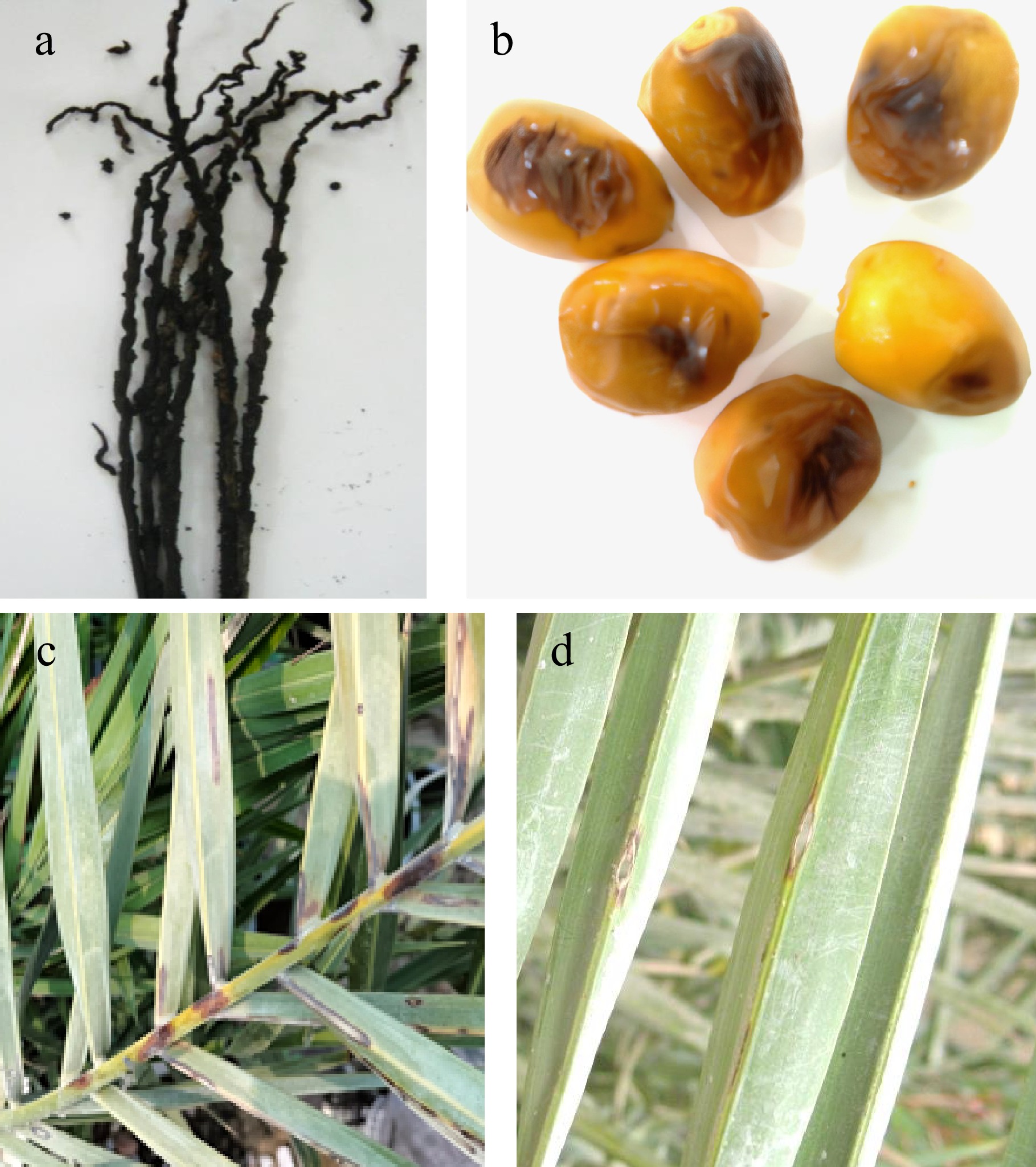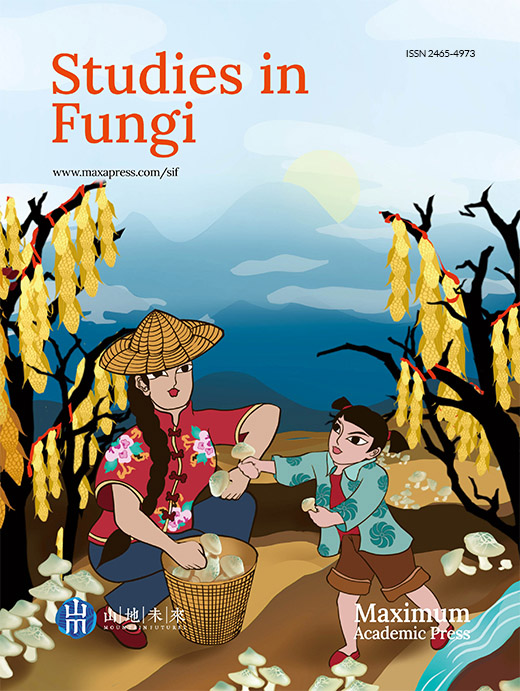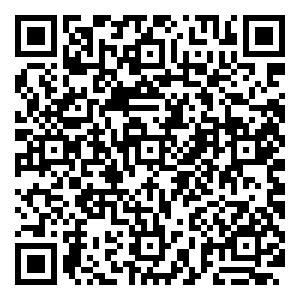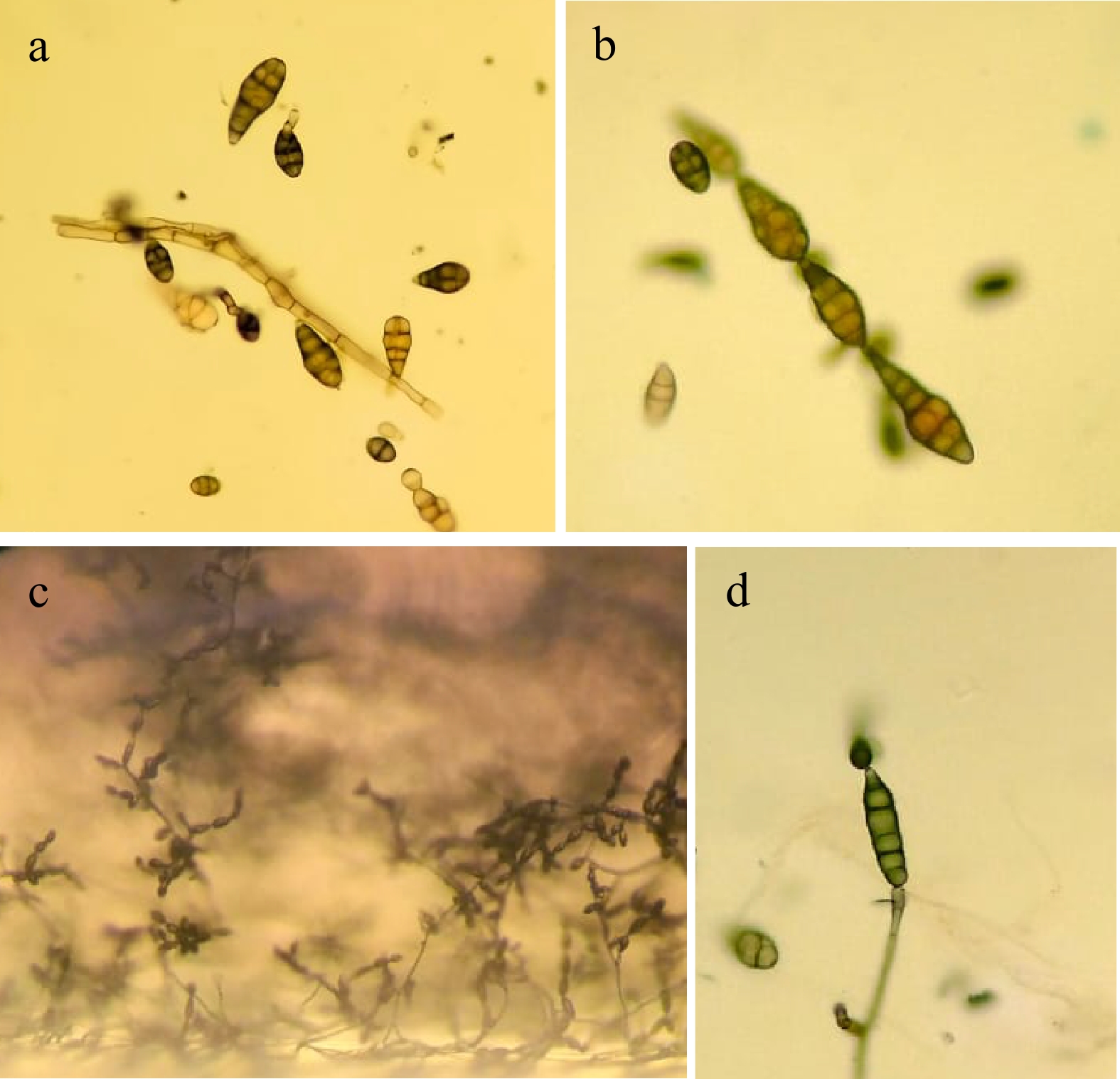-
The cultivation and growth of date palms are accompanied by the growth of several fungi on its various parts. Some of these fungi are beneficial and exist naturally on healthy parts without causing any harm to the plant, or can be applied to promote the growth of the plant. The relationship between fungi and plants may be symbiotic, especially with root fungi, which play a very important role in promoting plant growth by contributing to making some nutrients in the soil ready for absorption[1]. In addition to protecting the plant against pathogens, such as stimulating plant resistance and others. An example of beneficial fungi are mycorrhizal fungi, as adding them to the soil contributes to protecting palm seedlings against the fungus Fusarium chlamydosporum, which causes palm seedling decline disease, by reducing the infection with this pathogen[2]. Also, Trichoderma fungus plays an important role in combating some date palm pathogens. However, some other fungi cause diseases by infecting one of the parts of the palm tree. These fungi may be specialized in infecting one part of the palm, as they do not infect another part or are not even present on it, such as the fungus Mauginiella scaettae, which causes inflorescence rot disease, as this fungus attacks only the inflorescence of palm[3]. Likewise, the fungus Serenomyces phoenicis that causes rachis blight disease, which does not infect other parts of the leaf except the leaf rachis[4]. These fungi were not isolated from palm parts other than the parts present on them. There are several fungi that can grow on all parts of the palm tree as a pathogen or as a fungus accompanying the infection. Also, it can be found on the outer surface of insects and their larvae that infect the date palm. One of the most abundant and important of these fungi is Alternaria alternata. This fungus causes significant diseases in date palm, impacting yield and quality, and is also present in some infection sites as a secondary pathogen compounding the damage caused by primary infections. For this reason, this article highlights the exploration of the properties of this fungus, the diseases it causes, and control strategies, ultimately ensuring healthier date palm trees and improved yields.
-
Alternaria is found in various regions of the world as a saprophytic fungi in the soil or on plant residues[5−7]. However, some of its species infect a number of plants and cause diseases[8]. It is one of the important fungi that causes diseases in the field, such as heart rot disease in pomegranates[9], leaf blotch and fruit spot disease on apples[10], or post-harvest disease, for example, broccoli black spot[11], tomato fruit rot[12], apple fruit rot[13], and kiwi fruit rot[14]. This fungus is one of the important fungi that cause leaf spot diseases on plants, such as gerbera leaf spot disease[15], blackberry leaf spot disease[16], and soybean leaf spot disease[17]. Alternaria were described by Nees von Esenbeck[18], with A. tenuis being the species representing the general description[19]. There are approximately 368 species belonging to the genus Alternaria[7]. The sexual form of Alternaria features small, dark brown, round to oval structures that are either embedded or on the surface. These structures have single chambers with small openings and thin walls. Inside, there are cylindrical sacs containing spores, surrounded by broad cellular filaments and ellipsoidal to fusiform, pigmented spores, the sexual form has been documented in species within the sections Alternaria, Crivellia, Embellisioides, Eureka, Infectoriae, Nimbya, and Panax.[7,20]. Species of this genus produce asexual conidia that are divided longitudinally and transversely, are dark in color, and are in the form of branched or single chains[21]. The fungal species can grow in different environmental conditions. When the environmental conditions are not suitable for growth, they remain in the soil, on the dead plants, or in the host plant tissues in the form of spores or mycelium[22]. Fungus spores germinate when appropriate moisture is available, and the appropriate temperature for germination ranges between 25−35 °C[23]. The fungus is transmitted from one place to another in the form of spores by the wind. Among the characteristics that distinguish these types of fungi are the production of melanin pigments in the spores and the production of toxins for pathogenic species[22]. In addition, it is characterized by its ability to change its lifestyle from a saprophytic fungus to a pathogenic fungus[22].
-
There are a number of Alternaria fungal species that have been isolated from different parts of the date palm. Most of these species have been isolated as causes of leaf spot diseases (Table 1). Also, some of them accompanied insects and mites that attack palm trees[24]. These species are namely: A. alternate[25,26], A. longipes[26], A. diynthicola[27] A. radicina[28], A. chlamydospra, A. arborescens, A. consortialis[29]. A. raphani[30], A. tomato, and A. burnsii[31]. The fungus A. alternata is one of the most abundant species in the date palm surroundings.
Table 1. Presence of Alternaria species in date palm orchards across various regions.
No. Alternaria species Date palm portions Inflo Fruits Leaves Roots Insects &
mites1 Alternaria alternata + + + + + 2 A. arborescens − − + − − 3 A. burnsii − − + − − 4 A. chlamydospra − − + − − 5 A. consortialis − − + − − 6 A. dianthicola − − + − + 7 A. longipes − − + − − 8 A. plurispora − − + − − 9 A. radicina − − + − − 10 A. raphanin − − + − − 11 A. tenuissima − − + − − 12 A. tomato − − + − − +, present; −, not present. -
Fungi belong to the kingdom fungi and the phylum Deuteromycota, also known as the imperfect fungi[22] (Table 2). The fungus secretes a group of enzymes that help it cause plant diseases. In addition they produce two types of toxins, which are non-host-specific toxins such as Tentoxin[32] and host-specific toxins (Table 3). These toxins are produced by pathogenic isolates of the fungus A. alternata, while non-pathogenic isolates do not produce them. These toxins have a role in increasing the severity of the disease and also are considered toxic to other plant species generally[33]. Fungi can grow on several artificial culture media, such as: Cornmeal agar, potato dextrose agar, V8 agar, glucose-nitrate agar, and yeast peptone agar. The growth of fungal colonies and the size of the spores formed are affected by the components of each medium. It was noted that the size of the spores formed on culture media was smaller than the size of the spores formed when fungal isolates were grown on tomato stem pieces in the laboratory[34]. The fungus A. alternata that grow on potato dextrose agar medium at 25 °C, forms a colony with a dark gray to olive color and conidia in chains. The shape of the conidium is oval or elliptical, divided transversely and longitudinally, with a short beak (Fig. 1). This fungus is found on date palm trees, either as a secondary cause of disease, such as false frond disease (yellowing of fronds)[35], offshoot decline disease[36] or it exists as a primary pathogen.
Table 2. Scientific classification of A. alternata.
Biological classification Name Kingdom Fungi Subkingdom Eumycota Phylum Imperfect fungi Class Hypomycetes Order Moniliales Family Dematiaceae Genus Alternaria Species Alternata Table 3. Host-specific toxins produced by A. alternata.
Fungi species Host plant Disease Toxin Ref. Alternaria alternata Spotted knapweed Black leaf blight of
spotted knapweedMaculosin- toxin Stierle et al.[37] Alternaria alternata Sunflower Leaf disease of sunflower AS-toxin Liakopoulou-Kyriakides et al.[38] Alternaria alternata f.sp. citri Rough lemon Leaf spots of rough lemon ACR-toxin Masunaka et al.[39] Alternaria alternata f.sp. fragariae Strawberry Black spot of strawberry AF-toxin Maekawa et al.[40] Alternaria alternata f.sp. kikuchiana Japanese pear Black spot of Japanese pear AK-toxin Tanaka et al.[41] Alternaria alternata f.sp. lycopersici Tomato Stem canker of tomato AAL-toxin Bottini & Gilchrist[42] Alternaria alternata f.sp. mali Apple Alternaria blotch of apple AM-toxin Johnson et al.[43] Alternaria alternata f.sp. tangerine Tangerine Alternaria brown spot ACT-toxin Kohmoto et al.[44] -
This is one of the important diseases on date palms in several countries, such as Iraq, the Arabian Gulf countries, and North Africa. It is also found in Iran, Spain, and Italy. The main cause of this disease is Mauginiella scaettae Cav. This fungus infects inflorescences and causes them to rot completely or partially. In addition, several fungi associated with inflorescences rot were isolated, such as Fusarium moniliforme, F. solani, F. oxysporum, F. proliferatum, and Thielaviopsis paradoxa. Also, this disease is caused by the bacterium Serratia marcescens[45,46]. Furthermore, it has been noted that this disease is caused by the fungus A. alternata. This fungus infects the inflorescences and causes rusting of the flower[47,48] (Fig. 2a). This fungus was isolated individually from palm pollen samples that showed symptoms of inflorescence rot. This fungus infects several palm varieties: Ghanami, Halawi, Sayer, Khadrawi, and Dairi. The pathogenicity test demonstrated the ability of the fungus A. alternata to infect healthy pollen and cause symptoms similar to natural infections in the field[47].

Figure 2.
Date palm diseases caused by A. alternata. (a) Inflorescence rot. (b) Fruit rot. (c) Leaf spot. (d) Shoot-hole.
Fruit rot
-
Date palm fruits are exposed to infection bu several fungi during their growth stages, which leads to their damage. Thus, it affects its economic value. Factors that contribute to infection are humidity, rain, cracks and wounds on the fruits. This disease is caused by several fungi that attack the fruits, and yield losses may reach about 70% generally. The infection appears either as rot near the apical end of the fruits[49] or as lateral rot, as in cases of infection with the fungus A. alternate[49,50] (Fig. 2b). The symptoms on infected fruits are in the form of dark black spots, which is a soft rot that expands as the infection progresses. Thus, it leads to shrinkage and fall of fruits. Laboratory experiments have proven that the fungus can cause infection at all stages of the fruit except the Tamar stage, Table 4, and the results showed that the fungus was not able to infect unwounded fruits[50].
Table 4. Infection percentage of different varieties of dates and their growth stages with the fungus A. alternate[50].
Fruit stage growth of the date palm Cultivar Tamar Rutab Khalal Kimri Control Unwounded Wounded Control Unwounded Wounded Control Unwounded Wounded Control Unwounded Wounded 0 0 0 0 0 30% 0 0 63% 0 0 51% Sayer 0 0 0 0 0 33% 0 0 50% 0 0 55% Barhi 0 0 0 0 0 20% 0 0 22% 0 0 32% Zahidi 0 0 0 0 0 11% 0 0 44% 0 0 21% Hallawi Leaf spot disease
-
Date palm leaves are infected with several fungi that cause tissue damage and death. The affected areas appear as spots of different sizes and shapes, which may be circular, longitudinal, regular, or irregular. Although this disease spreads throughout palm cultivation, it is not an epidemic disease. The disease severity depends on the type of date palms variety, agricultural practices, and environmental conditions. Usually, the infection begins on the old leaves and then spreads to the inner fronds of the palm tree. The fungus A. alternata is one of the main and common causes of leaf spot diseases. Symptoms of spotting due to infection with the fungus A. alternata appear on both sides of the leaflets and sometimes on the rach of the leaf. (Fig. 2c). It appears as light brown spots with dark brown to reddish edges[47]. Also, the fungus A. alternata may be involved with other fungi in causing leaf spot, as the fungus A. alternata and Fusarium sp. were isolated from the same spots on the leaf[27]. The A. alternata frequency when isolated from leaf spot was 68% compared to the frequency of fungi associated with causing the same spot[51].
Shoot-hole disease
-
The fungus A. alternata causes small shoot-holes on date palm leaves. The infection begins in the form of brown or pale spots surrounded by a yellow halo or brown rings, and as the infection progresses, it leads to the separation of the affected tissue from the healthy tissue and thus its fall (Fig. 2d). These symptoms appear on both sides of the leaflets in different places[47,52]. The effectiveness of this fungus has been proven in the laboratory to cause infection and the appearance of hole symptoms on the leaves. Date palm varieties differ in their sensitivity to infection with this fungus[52].
Diagnostic process
-
There are several methods that can be followed to diagnose infection with the fungus Alternaria alternata. First, a visual diagnostic, although this method is inaccurate in determining the type of pathogen. However, it may be useful as a preliminary diagnosis of infection. For example, it is not possible to determine the type of pathogen of inflorescence rot through field observations because this disease is caused by several pathogens. Therefore, all of these pathogens infect inflorescence and cause symptoms of rot. The second method is microscopic examination of infected tissues and isolation of the pathogen: examining infected tissues under a microscope allows fungal structures such as spores and mycelium to be seen. By culturing pieces of these tissues on culture media, pure isolates can be obtained. Thus facilitating the diagnosis and identification of the fungus A. alternata. However, the morphological similarity between the Alternaria fungus genera may lead to incorrect diagnosis, and therefore the molecular diagnosis method can be used, which is considered one of the more modern and accurate methods of diagnosis. Also, through epidemiological studies, it is possible to determine the date of infection, especially seasonal diseases such as inflorescence rot disease and fruit rot disease in general. However, all of these methods should be applied to obtain accurate and reliable results in determining infection with the fungus A. alternata.
-
Taking care of horticultural services is considered a basic step in combating diseases, as this is done by removing parts of palm trees infected with the fungus A. alternata and burning them. Sterilizing the tools used in pruning while avoiding causing wounds that may cause diseases. Plant palm trees at appropriate distances and organize the irrigation process, which will reduce humidity and thus limit the spread of fungi between trees. Also remove weeds, which may be a secondary source of infection.
Chemical control
-
It is considered a fast and effective method of control, but it causes environmental damage if not applied correctly. Therefore, specific fungicides must be used to target the pathogen A. alternata and thus prevent its spread. A study found that foliar application of two fungicides significantly reduced the incidence of Alternaria sp. infection on date palms, with a reduction of 17.87% for pentanol and 22.56% for Score. Additionally, these fungicides significantly inhibited the growth of the pathogen in vitro[53]. Another study was conducted by Kassem et al.[54] to test the effect of fungicides Bellis, Maystic, Rovral, and Switch on the development of date fruit rots caused by several pathogens, including A. alternata. The results showed that Bellis, at all tested concentrations was an effective fungicide in controlling fruit decay caused by A. alternata, Bellis recorded disease severity of 28.20%, 17.79%, and 8.85% , at concentrations 125, 250, and 500 ppm respectively, compared to other fungicides and the control treatment.
Resistant varieties
-
Selecting and planting resistant varieties of date palm is an important way to remove diseases caused by the fungus A. alternata. Thus, it will reduce the costs of using fungicides and their harm to the environment. Natural resistance can be identified in certain date palm varieties to A. alternata infection, then can be selectively grown. Additionally, understanding the genes responsible for resistance and their mechanisms is crucial. Genetic engineering techniques can be used to introduce resistant genes, allowing for genetic modification in date palms.
Biological control
-
Biological control has been used to control A. alternata by applying microorganisms like fungi and bacteria. In a study conducted by Alasadi & AlSadoon[48], the antagonism between Trichoderma harzianum and A. alternata, which causes inflorescence rot diseases, was shown to have an antagonism degree of 73.3%. Mansour et al.[55] found that A. alternata isolated from leaf spots on date palm was inhibited by T. harzianum (70.56 %) and Bacillus spp. (42.2%) in vitro.
-
The A. alternata fungus is considered very important because it causes many diseases in date palms and thus affects their productivity. To protect date palms, it is necessary to understand the biology of this fungus and the environmental conditions suitable for its spread. In addition, pointing out the various control methods that limit the spread of this fungus in date palm orchards. Thus, future research should focus on molecular technology to develop resistant date palm varieties to A. alternata, besides developing predictive models that help to forecast pathogen outbreaks.
-
The author confirms the sole responsibility for all aspects of the research and manuscript preparation.
-
All data for this study were gathered from the sources listed in the reference section and analyzed accordingly.
-
The author declares that there is no conflict of interest.
- Copyright: © 2024 by the author(s). Published by Maximum Academic Press, Fayetteville, GA. This article is an open access article distributed under Creative Commons Attribution License (CC BY 4.0), visit https://creativecommons.org/licenses/by/4.0/.
-
About this article
Cite this article
Alasadi RMS. 2024. Alternaria alternata: the most common pathogen on date palm. Studies in Fungi 9: e012 doi: 10.48130/sif-0024-0012
Alternaria alternata: the most common pathogen on date palm
- Received: 01 May 2024
- Revised: 15 July 2024
- Accepted: 25 July 2024
- Published online: 03 September 2024
Abstract: Alternaria alternata is one of the most widespread fungus that infects a wide range of plants worldwide due to its ability to infect diverse host plants, this fungus presents on date palms and their environment. This review discusses information about the species of Alternaria that infect date palms and focuses on the fungus A. alternata and its control strategies. It also discusses the importance of the genus Alternaria and the environmental factors that help in its spread, such as temperature and humidity. It also mentions the diseases caused by the fungus A. alternata, such as inflorescence rot, leaf spot, shoot hole leaf, and fruit rot on date palms, and the common symptoms resulting from the infection. In addition, the review refers to control methods in general, such as chemical control, cultural practices, and resistant varieties, as strategies used to limit the spread of the fungus A. alternata and thus prevent the occurrence of diseases.
-
Key words:
- Plant pathology /
- Alternaria alternata /
- Fungal pathogen /
- Environmental factors /
- Symptoms /
- Disease management /
- Date palm













